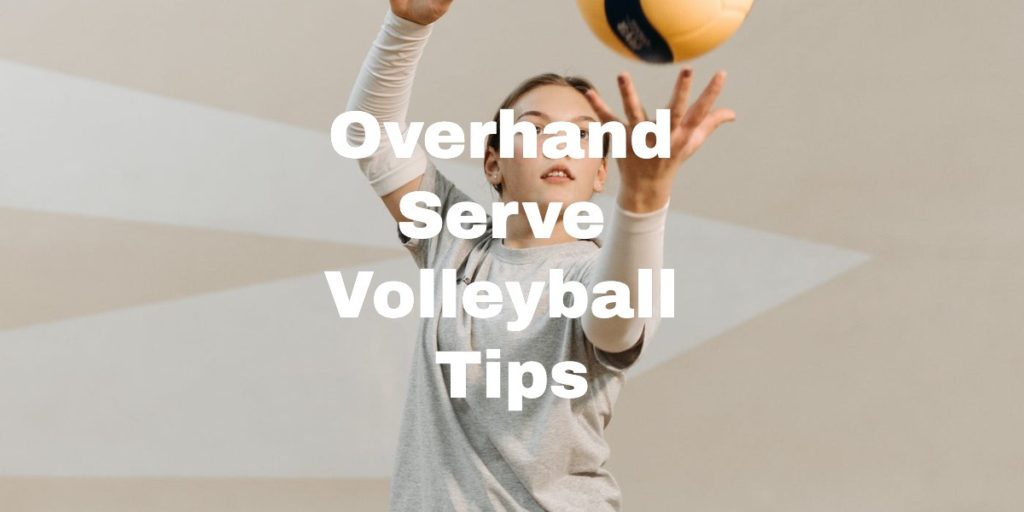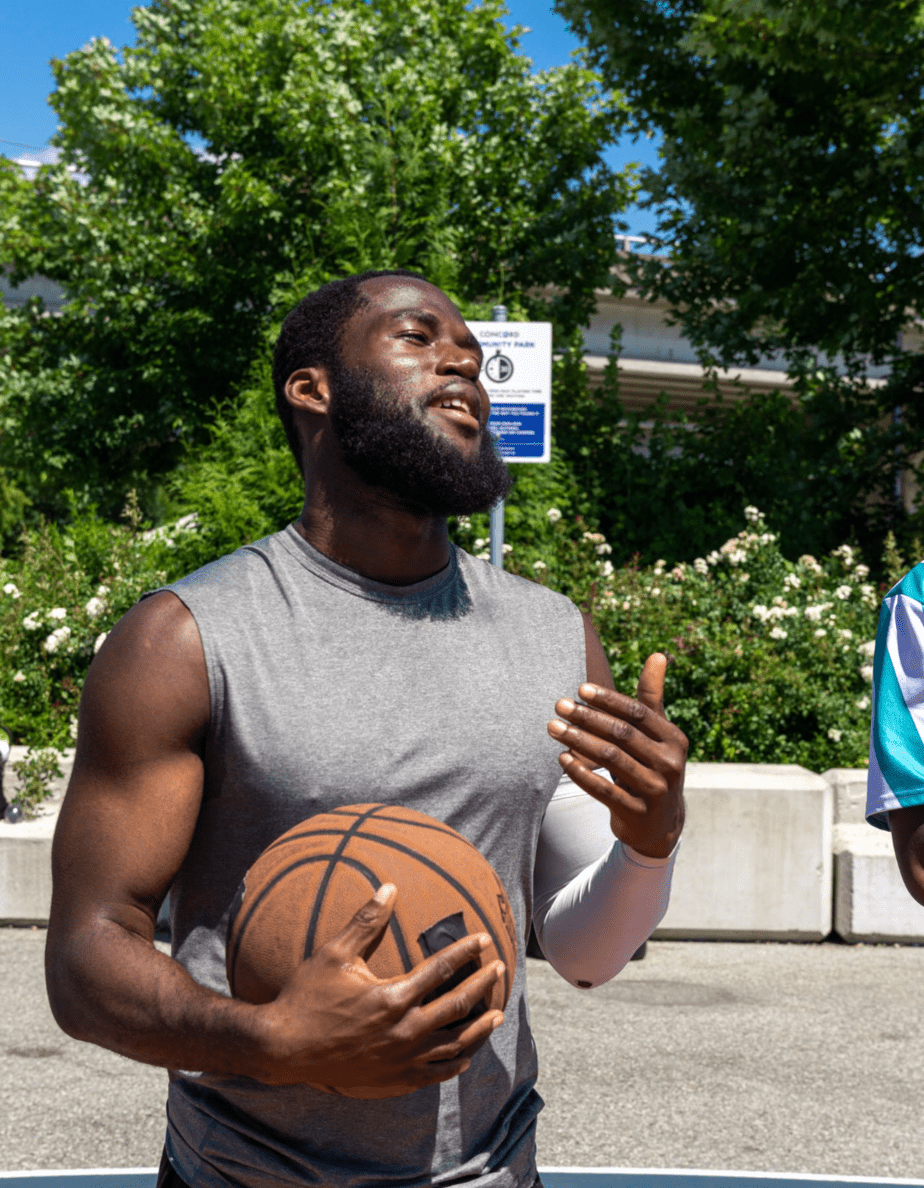How To Do An Overhand Serve In Volleyball: Tips For Beginners
I am guessing you may be in the same position I am. My 12-year-old daughter really enjoys volleyball and we wanted to give her a fighting shot at making her middle school team this year. But, she just wasn’t getting the mechanics of doing an overhand serve in volleyball. And that was really going to hold her back. Living in volleyball-crazed Omaha, Nebraska with two top 20 college volleyball programs (Creighton and the University of Nebraska), there is no shortage of volleyball training facilities.
We signed her up for clinics at Creighton University, Elite Volleyball, The Courts Volleyball Club, and even private lessons at Banzai Volleyball. All of them helped and are good programs but she still wasn’t getting her overhead serves over the net consistently. Some of the coaches’ feedback was that she needed to get stronger. I think she is going to be an ectomorph body type like me, which translates into less natural upper-body strength. More on that later in the post.
I may not be a volleyball expert, but I have done a massive amount of research and cataloged every overhand serve volleyball tip and resource I could find. I talked to coaches and scoured the internet, and Youtube. My hope is that I can update this post in the Fall saying that my daughter made the volleyball team and that the information in this post helps your young volleyball player as well. Here are the 3 major things that I will cover.
- Basic steps to overhand serve.
- Resources and videos that helped us.
- The one big item that really turned things around for my daughter.
Understanding the Basics of Overhand Serve
An overhand serve in volleyball involves standing behind the end line, tossing the ball up, and hitting it overhand into the opponent’s court. It offers power and control, making it a preferred choice for many players, and can disrupt the opponent’s return strategy.
Steps to Execute an Overhand Serve
- Proper positioning and body alignment: Begin by standing a few feet behind the end line. Position your feet shoulder-width apart, with your non-dominant foot slightly in front. This staggered stance provides balance and aligns your body toward the target area.
- Overhand serve technique: Hold the ball in your non-dominant hand and extend it out in front of you. Your hitting hand should be held open, similar to a high-five position. Toss the ball upwards and slightly in front, stepping forward with your dominant foot as you swing your hitting hand up to make contact.
- Avoiding common mistakes: Overhand serves can be tricky, and there are several pitfalls to watch out for. For instance, hitting the ball too hard can send it out of bounds, while a weak hit might not even make it over the net. It’s important to focus on accuracy over power, especially when you’re just starting out.
How To Overhand Serve For Beginners
I really enjoyed the videos from Coach Koko on Youtube. She has a really approachable style, and, she just seems so darn nice. She has a large library of volleyball videos, but this one on overhand serving for beginners walks through all of the mechanics. I wish they filmed it to see her entire body movement throughout the video but you do get to see her full motion at the end.
Overhand Serve In Volleyball Tips
Perfecting Your Overhand Serve Toss
The toss sets the stage for your serve. A good toss is consistent, and predictable, and gives you ample time to align your hitting hand. Start by holding the ball in your non-dominant hand at waist level. Toss the ball about 2-3 feet above your head, stepping into the toss to generate momentum for your serve. Remember, consistency is key—try to mimic the same toss every time.
Strengthening Your Serving Arm
A strong serving arm contributes to both the power and accuracy of your overhand serve. Incorporate exercises like dumbbell snatches, dumbbell pullovers, 10-and-2 drops, biceps with overhead press, push-ups, tricep dips, and resistance band workouts into your routine to strengthen your upper body. Flexibility is equally important, so don’t forget to include dynamic stretching exercises to keep your muscles limber and ready for action.
Mastering the Art of Serve Accuracy
Improving your serve accuracy is an important part of mastering the overhand serve. One method several coaches suggested is visualizing the target area before serving. Focus your gaze on the spot where you want the ball to land, and try to hit it there. Setting up targets during practice can also be beneficial—aim to hit these targets consistently to improve your accuracy over time.
Enhancing Serve Speed
Speed can make you’re overhand serve more difficult to return. To improve your serve speed, focus on your arm swing. Your arm should move in a whip-like motion, starting slow and accelerating as you make contact with the ball. One of our coaches explained it to us using the analogy of a hammer. Incorporate plyometric exercises into your training routine to boost your arm speed and power.
Here is the thing that turned things around for my daughter. The coaches at Bonzai Volleyball talked about rotating your body and stepping into the ball. Their analogy was like what a baseball pitcher does to gain power and ball speed. If they just use their arm there won’t be a lot of strength, but stepping across your body and towards the batter generates a ton of power.
They did some drills to encourage that but it wasn’t totally sinking in for my daughter. My daughter went to a volleyball clinic put on by her eventual high school and was disappointed that she, again, didn’t get any overhand serves over the net. That night I took her out and just had her throw a volleyball with a pitching motion as hard as she could into the garage door.
Throw after throw she was just throwing the ball without crossing her body and stepping into it. And then about the 8th rep, she finally got it. Later that night, unprompted, she went out to the backyard and hit some balls, and came in to get me very excited. She said she hit 4 balls in a row over the net! We will see what happens, the second day of the clinic was this morning. I will find out what happened when I get home.
Dealing with Common Overhand Serve Challenges
Let’s face it, overhand serving can be challenging, especially for beginners. Issues like inconsistent tosses, weak serves, or lack of control can be frustrating. However, remember that practice makes perfect. Focus on one aspect at a time, be it the toss, the swing, or the follow-through, until you see improvement.
How To Practice Overhand Volleyball Serve At Home
This is a great video by former USC volleyball libero player Victoria Garrick. I have forwarded it below to the serving section where she demonstrates several ways to practice your overhand volleyball serve at home and by yourself. Garrick also has an interesting podcast talking about body image and life after volleyball. I have shared a couple of relevant episodes with my daughter.
Step 1: Choose Your Space
To start, find a suitable space for practicing your serve. A sturdy wall or a garage door works well. Ensure the chosen structure is tough enough to withstand the impact of the volleyball.
Step 2: Mark Your Target
Next, to add precision to your practice, mark a square on the wall with tape. This square will serve as your target area, simulating an area of the volleyball court. Aim to consistently hit your serves into this target area.
Note: Be mindful of your surroundings. In some cases, like if the garage is sensitive, be sure not to cause any damage.
Step 3: Get Into Serving Position
Now that you have your target set up, get into your serving position. Go back to Coack Koko’s video for a refresher.
Step 4: Execute the Serve
From this position, go ahead and execute your serve. Swing through with your dominant arm and aim to hit the ball into the marked square on the wall. Try to maintain consistent form with each serve, and focus on hitting your target.
By practicing in this way, you can get a lot more practice without access to a net or a court, or even another person. We also bought a spike trainer that attaches to our basketball hoop. It can also be used to practice the hitting motion for a serve with the benefit of not having to chase the ball each time you hit it.
Incorporating Overhand Serves in Game Strategy
An effective overhand serve can greatly disrupt your opponent’s game plan. By varying your serve’s direction and speed, you can keep your opponents guessing and gain an advantage. Practice different serve strategies and observe how your opponents react. This information can be useful in adapting your serving strategy during a game.
The Importance of Practice and Persistence
Mastering the overhand serve doesn’t happen overnight. It requires consistent practice, patience, and a positive mindset. Don’t get discouraged by missed serves or mistakes. Instead, view them as learning opportunities and use them to refine your technique. Remember, even professional players started where you are now—it’s the dedication to improvement that sets them apart. I have bought volleyball arm sleeves for my daughter to ease the pain from all the contact.
Conclusion
Mastering the overhand serve is a journey, and it’s okay to progress at your own pace. With regular practice, you’ll start to see improvements in your power, accuracy, and consistency. Remember, the most important part is to enjoy the process and have fun with the game. I will update this post with any other overhand serve volleyball tips and tricks as I find them.

Troy Wallace
Troy Wallace is Certified Basketball Speed Specialist and shares his experiences in trying to stay as healthy as possible to stay on the court. He is active in coaching youth basketball in YMCA, Team Work Sports Nebraska, and, currently, in the Jr. Warriors program in Omaha, NE. Visit Troy's Full Author Bio Page or email him directly.
Meaningful conversations happening daily about training, recovery, and injury-specific rehabilitation as well as sport-specific discussions on playing, coaching and refereeing your favorite sport. We welcome experts and those with curious minds seeking answers.
Join The Stay On The Court Community!